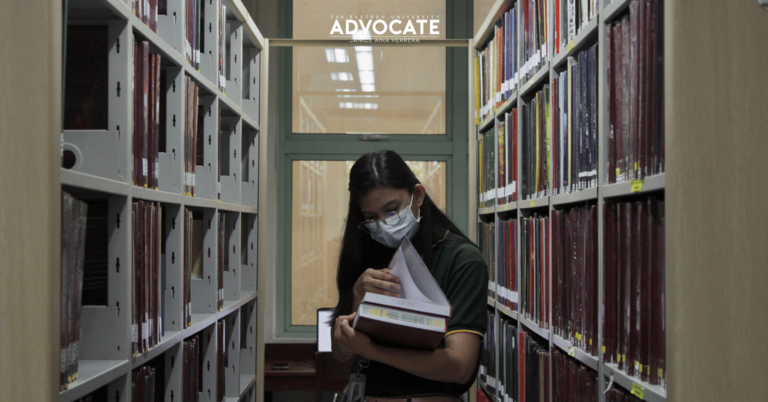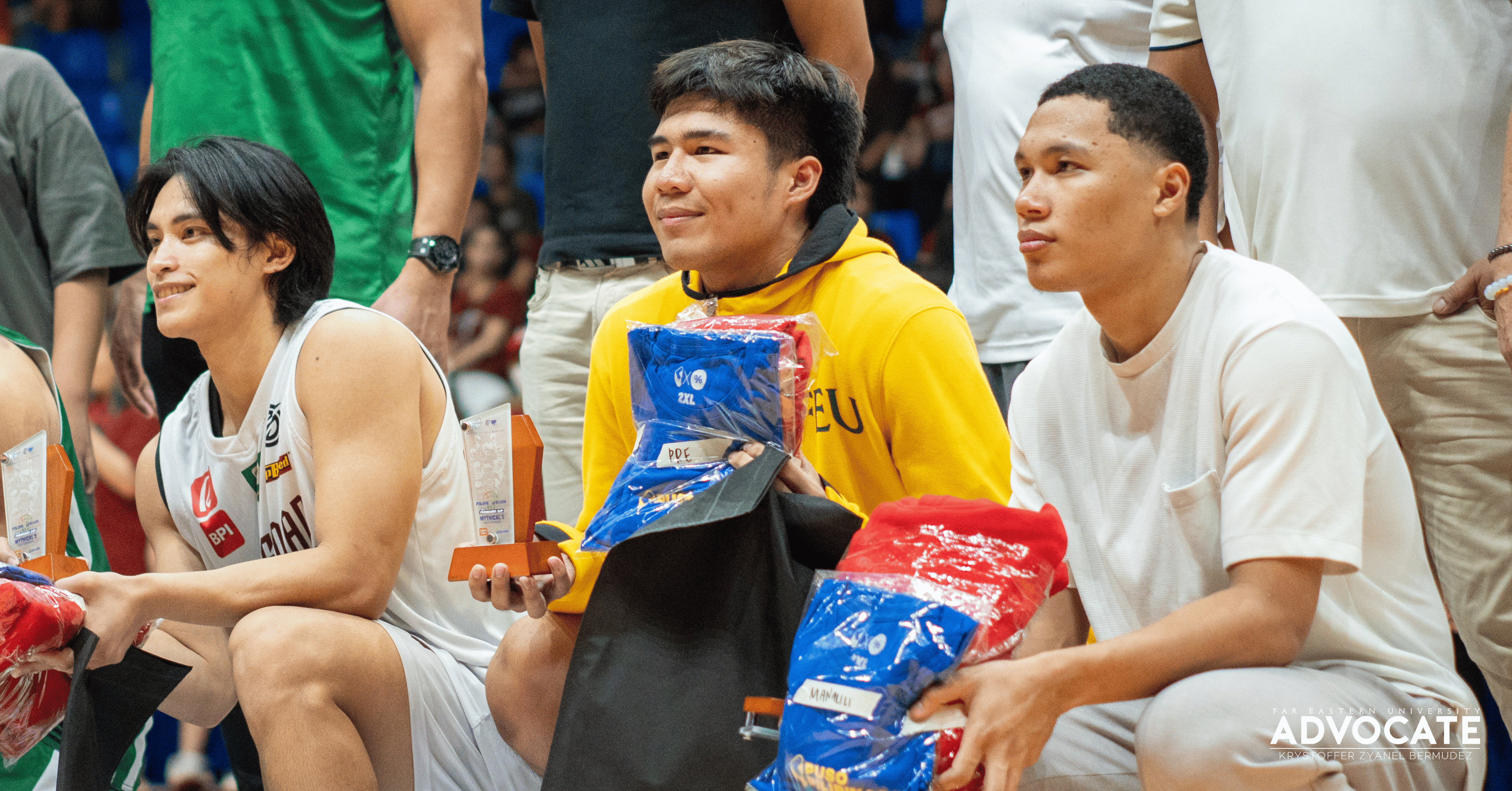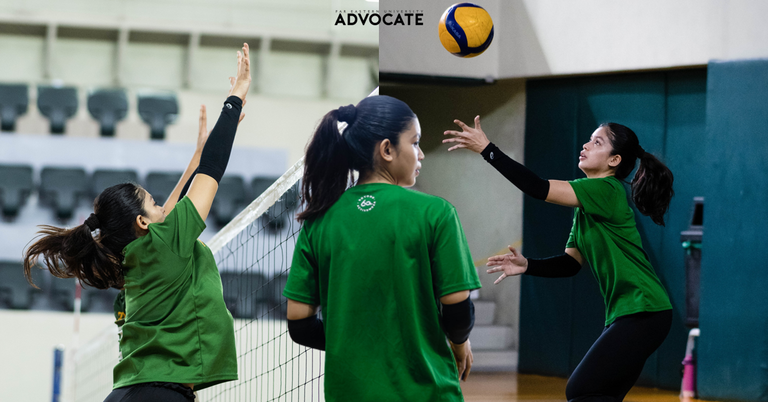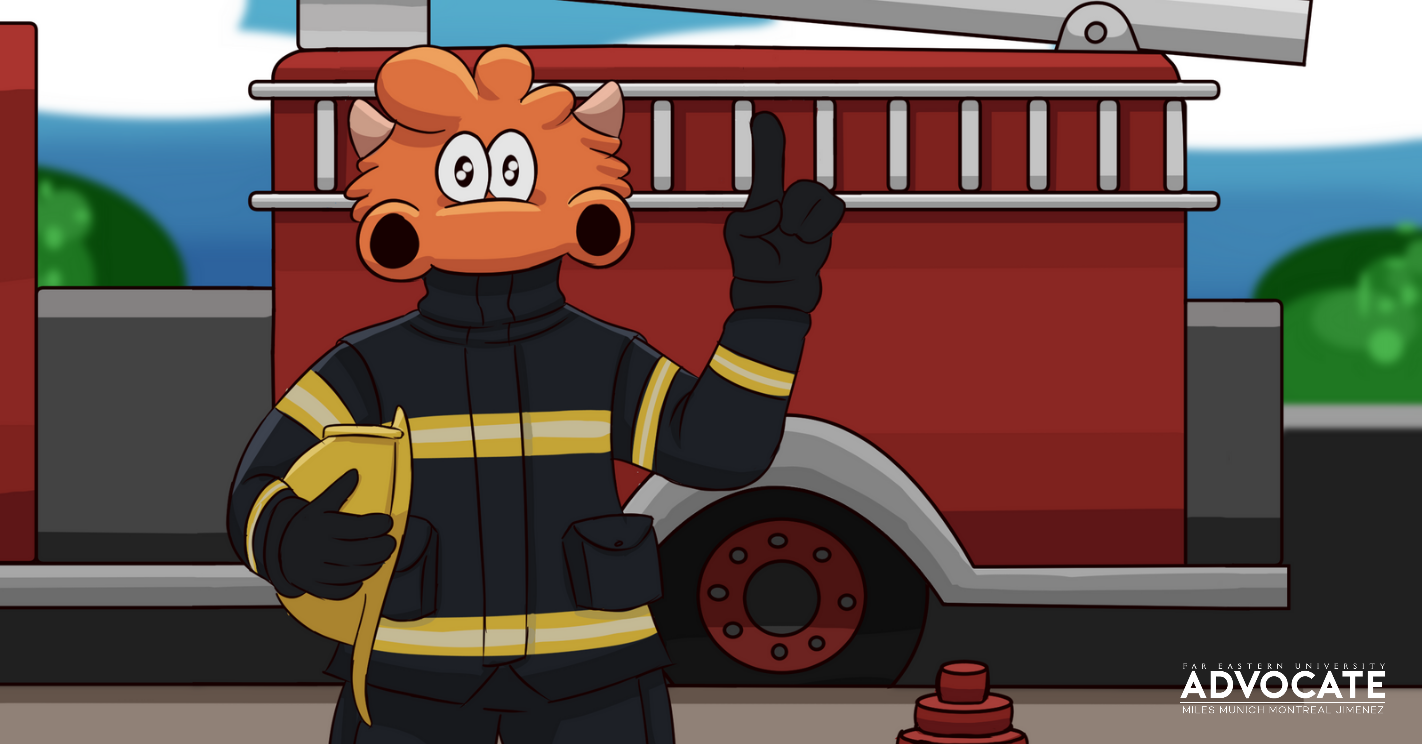
TAMready! Ways to mitigate sirens along Morayta-España streets
- March 30, 2024 08:43
FEU Advocate
June 14, 2021 11:00
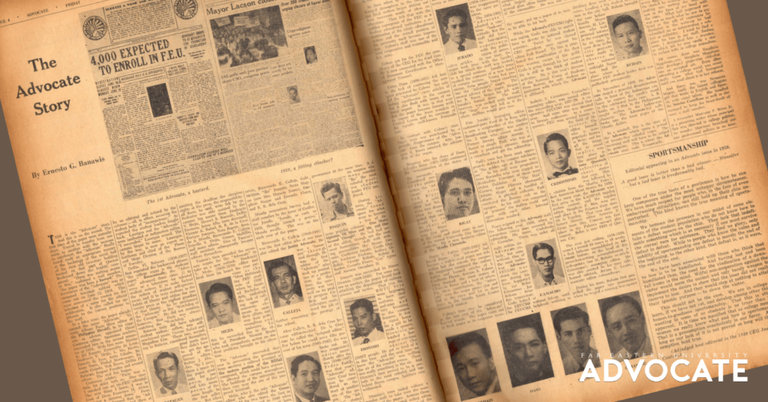
By Ernesto G. Bunawis
(This was originally published on 12 June 1959 Volume XXI no. 49 issue of FEU Advocate, in celebration of its silver jubilee anniversary)
This is the “Advocate” story. And this is on the record. The first days of the paper were nomadic days. Forced to transfer from one room to another with the increase in enrollment, the “Advocate” finally found itself an appropriate nursery at the backstage of the social hall of the then old two-story building located on that part of Quezon Boulevard down the NARIC compound.
“There was nothing remiss in this,” explained a staff member, “the paper was born a bastard.” The forerunner of the “Advocate” was an unnamed ten-page tabloid which came out on June 12, 1934. This issue announced the contest for the selection of a name for the official publication. It also called for applicants to the various positions in the staff.
In a later issue, the paper already carried the name “Advocate.” Vicente Albano Pacis (then editor of the Philippine Herald), in his capacity as adviser, appointed Oscar Contreras editor, Saturnino Aricheta succeeded him in the second semester of 1934. With him were: Nicolas K. del Rosario, Esmeraldo de Leon, Prudencion V. Mejia, L, Ma. Rivera, Ernesto de Juan, Anita Udarbe, Bibiara Torio, Piedad Montenegro, Ricardo Guindo, Noli Reyes, Delfin Fl. Batacan, Isagani Fuentes and several others. The real fun began.
Contreras relates: “Pacis was a little bit strict with us. One time I sneaked out an un-FEU editorial. The next thing I knew, I was in front of Dean Francisco M. Africa, receiving a dressing down.” From Contreras we learned that the “Advocate” was being printed then at the Dia Filipina.
Aricheta gave the credit for conceiving the paper to the student leaders of the defunct Far Eastern College which merged with the Institute of Accounts, Business, and Finance to form the Far Eastern University. This group succeeded in convincing the late President Nicanor Reyes of the necessity of having a student publication.
The first “Advocate” alumni helped the administration in shoring-up the name of the university.
The next year, Nicolas P. Lansigan, then a UP forestry graduate and now with the department of agriculture and natural resources, was the first forest ranger to become editor, “My chief problem was to make the college organ a really dynamic campus institution,” he recalls. “Campus readership, then, was low and student interest in the paper was lacking. How to do it was the question.” He wanted to sell the “Advocate” to the students.
Lansigan found a scape goat: the student council. He observed that the financial management of the student government was not well taken care of. An expose was followed by an editorial and echoed by the columns—all, in effect, accusing the student body of “incompetence.” As expected, the student leaders fought back. Lansigan and the “Advocate” were lambasted at indignation rallies. “I succeeded,” Lansigan mused. The campus began to move. Lansigan, by the way, is now an expert on fertilizers and chief of the Plants and Maps Division of the Bureau of Forestry.
Delfin Fl. Batacan (1936-1937) first reprinted the hackneyed phrase: “the college organ is the students’ paper.” Batacanically, the “Advocate” advanced three aims” 1) to serve as a laboratory for talented student writers; 2) to make factual the system of student self-government; and 3) to train students in the habits of liberty and utilize the university press as the vigilant guardian of that liberty. So he proclaimed the “Advocate” as the “Watchdog of the Campus.” He did not mention, however, that Pacis was always watching the “Watchdog.”
Batacan truly did have talented student writers, rather, two self-proclaimed poets: Vicente Rafael and Hugodino Lim. These two, according to Batacan, considered themselves good poets that they didn’t have to get the approval of the literary editor, Rufino J. Abadies. “So I gave them a space in the paper good only for one poem. Rafael and Lim wrote poems of the same length. In the first galley proof, it is Rafael’s poem. But when the page proof comes, Lim’s poem takes the place. So Rafael has to run to the press and stop the flatbed machine just to change Lim’s creation with his.”
“Vic,” Batacan muses, “was my most troublesome staff member. He used to order, all for himself, a pancit worth P3.00. When I tired to remind him of our limited allowance (P15.00 per issue), he would just counter: “’Di kumain kayo ng ‘hopia.’”
The Advocate during Batacan’s termed moved on gingerly.
Batacan is now with the RGC, was formerly technical assistant on police matters to President Quirino. He is the first “Advocate” editor to become a member of the FEU faculty. Also the first “Advocate” man who married a fellow staff member, his society editor, the former Pura Torres.
The exacting but enjoyable life of the staff members was recalled to us by Redentor Ma. Tuazon (1938-1939). The recurring problems of meeting the deadline, the sleepless nights at the press, the responsibility; all these, he said, were felt by us, Redentor was ably assisted by the campus big names then: Prudencio V. Mejia, Manuel B. Buenafe, Delfin Fresnosa, Jaime Alba (now deceased). Vicente A. Rfael, R. R. dela Cruz, Enrique Joaquin, Nora Espejo, Amado A. Munda, Bienvenido E. Calleja, Priscillo S. Mejia, Gersom Mallinllin, and many others. Five of Tuazon’s staff members subsequently became editors themselves.
Tuazon’s time provided the necessary respite for the “Advocate” to take on a new outlook. Prudencio V. Mejia, (1938-1939) editor and fresh from his laurel the year previous as the “Most Outstanding FEU graduate of 1938” when he finished Bachelor of Arts, undertook the task of calling upon all university elements to unite their efforts and stop their petty wranglings and jealousies. In this he succeeded due to the efforts of President Nicanor Reyes who took sympathetic action on student problems bought to his attention.
The “Advocate” succeeded that year in preventing the government from erecting a railroad terminal at the eastern portion of the Bilibid compound, which could have seriously affected the campus atmosphere. The buildings of the university were then very near the site of the proposed terminal.
Mejia, who is the only “Advocate” editor who also edited the Green and Gold for two times, the first in 1938 and the second in 1940 when he graduated as Bachelor of Laws, gave his staff-members greater liberty in their writings. Significantly, the “Advocate” won second prize in an inter-university contest for best-edited campus tabloid.
The first “Advocate” editor to become president of the College Editors’ Guild, Amado A. Munda (1939-1940) with his staff enjoyed greater freedom, if not complete liberty of expression. “Liling” Roces became that year’s adviser. Munda headed one of the most cooperative staffs. This was the first harvest year of the “Advocate.” With hime were Primitivo C. Mauricio, Bienvenido E. Calleja, Galo Meliton, “Ike” Joaquin, Nena Magno (now Mrs. Horacio Torres), Simplicio Nuque and Gerardo Flores, and R. R. dela Cruz.
Munda remembers having had a staff member by the name of Guillermo Jurado. “Jurado, was early as 1939, thought himself a genius,” Munda recalls. This was on the sixth year of the paper.
Bienvenido E. Calleja (1940-1941) was the first editor who atone time also edited the Junior Advocate. He was a “tamaraw” through. He was the first editor of the “Advocate” who took up journalism as a profession. At that time, the university was very well on its peak of progress. Calleja and his colleagues continued the job of further cementing the prestige of the school.
After Calleja, R. R. dela Cruz became editor-in-chief. dela Cruz may be called the “eclipsed editor.” For before he could serve fifty percent of his term (1941-1942), the war broke out. He was reappointed editor immediately after the war (1946-1947). Pedro Padilla was that year’s “Advocate” adviser. Cruz’ time may be considered as the start of another era of the paper. The “Advocate” started to regain its role in the campus. From a fortnightly, it became a weekly. This happened during the term of Enrique “Ike” Joaquin (1947-1948).
Most of that year’s staff-members were young veterans. It is recalled that at the examination given for the selection of the staff, more than 150 took the test. That signalled a resurgence of active and hectic campus life. That year Leon O. Ty took over as adviser.
“Ike” was the second editor to hold the presidency of the College Editors’ Guild and the first to be editor and president of the student government at the same time. It is no surprise why many considered “Ike” the most colorful post-war student leader FEU produced.
During his term, the “Advocate” found space for what were to become a few of the more popular columns: One Man’s Opinion, Of Mice and Me, and One Second Thought. He had one of the ablest, though not the most harmonious, staff with striking personalities like Mauro Dionisio, Guillermo Jurado, Guido Ongpin, Kanlayao Foylona, Sedfrey Ordoño, Vicente Buhain, Ruben F. Santos, Gerardo Flores, “Guy” Agana and Antonio Orendain II.
Joaquin was succeeded by Mauro Dionisio (1948-1949). For some reason or another, the paper found itself attacking the department of military science and tactics. That year the ROTC boys were beginning to have their uniforms spick-and-span and very becoming to the campus femmes. It was a signal honor for a girl to be made a sponsor. Dionisio unleashed a barrage of criticisms against the DMST people. He got so tired of it in due time and the next time we knew the “Advocate” was sniffing the air of the comfort rooms. There was really something in the air. And Dionisio’s time proved to be a prelude to the most colorful and turbulent drama campus habitues ever witnessed.
Dionisio’s term ended without a regular staff to take over the management of the paper. Antonio Orendain II was appointed acting editor (1949). At that time, most of the “Advocate” boys were occupying high positions in the student governments. This was started by “Ike.” Dionisio himself was a two-termer in the FEUCSO. The “Advocate” literally took to the field of politics. An incident was retold to us that at one time a favorite of the paper was double-crossed in the election for the FEUCSO presidency. The “Advocate,” in its pages screamed: “I was robed!” This started the now famous Tinio and Agana case, the two being the principal protagonists in that year’s elections. The incident reeled on for a time until it caught with an administration official. The “Advocate” never relinquished its fight until Orendian himself resigned and put out the spurious Lampoon which headlined a heretofore unexpected move of the administration official concerned.
It was also during Orendian’s time that the famous Madame Fernandez case happened. The campus was rocked with dissensions in all ranks. In due time, however, the rumpus died down. Vital A. Tan became FEU president. Vicente Coloso took over the editorship (1949-1950). The “Advocate” stopped vapping.
Coloso sounded a call for sobriety and unity. In his editorials, the new e-in-c plucked more sober tones. The university reached it highest peak in enrolment that year: 26,559.
In their effort to create a more tranquil atmosphere in the campus, our local writers began dishing out their two-cents worth of ideas on education. They felt that with the sudden emergence of the FEU as a leading educational institution, a reexamination of the whole educational system and the overall position of the university itself become imperative. Coloso’s staff was one of the most cooperative and responsible and less noisy.
Coloso got for the FEU the presidency of the CEG for the third time. He is now connected with the Office of the Economic Coordination as Management Counsel.
Celso Dans (1950-1951) fell heir to the task of continuing the new spirit generated by Coloso. Not only did the “Advocate” carry articles of lasting significance in the campus, but it also dealt with issues of national import. It was in that year that the paper became famous with its expose of the Army scandals in Central Luzon and its coverage of the equally well-known Fernando case.
In contrast with Coloso’s time. Dans’ term was punctuated by a periodic disappearance of the “Advocate” from the campus. Atty. Joaquin R. Roces assumed the advisership of the organ.
Stepping intp the shoes of Dans, Salvador Bigay (1951-1952) continued the “reexamination of the status of the university.” Considered one of the prolific writers ever had, Bigay cause a mild, silent war between two deans when he suggested that one should be in the shoes of another. Bigay won first prize in the essay and short story in one of the annual University Dat literary contests. He is now business editor at the Manila Chronicle.
Dante U. Calma (1952-1953) followed Bigay. The “Advocate” had become a widely-read paper not only within but also outside the campus. Its magazines contained the authoritative and learned articles of J. Gualberto Planas, Arsenio R. Fabros, Greg Stunead, the short stories of Clemente Roxas and a host of others. For their contributions, the “Advocate” won the major prizes (1st and 2nd in the essay and 1st in short story) in the Manila Youth Center sponsored contest.
Calma’s time may be considered as the last year of the “Advocate” harvest season. The paper came out in book paper in its magazine issues. Calma was a responsible for getting a more or less permanent office in the FEUCSO building for the “Advocate” which up to that time had been continuously wandering. At one time it even occupied a dark, low-roofed cubby hole.
Camilino A. Curaming (1953-1954) tookover where Calma left off. Presently editor of the Manila Confidential, Curaming upon his assumption of the “Advocate” editorship showed tendencies of a hard-biting newspaperman with his column monikered “FEU Confidential.” Curaming changed the make-up of the paper using more sub-heads than usual. With his side-kick, Alfonso Policarpio, Curaming instituted a “reign of terror” with an iron-fist but human discipline. He propelled the publication for no more than a semester, after which he resigned.
Gonzalo Jurado was appointed acting editor in Curaming’s place. Jurado, now with the much-publicized ACCFA, enjoyed one of the longest terms as editor. For at the start of the school year (1954-1955) he was reappointed to the same position.
The 1954-1955 “Advocate” adopted a cautious “look-see” attitude. But the staff did have its hair-raising experiences with the publication of provocative articles. At one time, the paper took issue with the faculty club for which the staff was invited to a special seminar. Jurado’s term marked the entranced of a new batch of campus writers. Young but promising, these people began crawling into the “Advocate’s” pages. The present adviser of the paper, Alejandro R. Roces, began his job with Jurado’s formal term. The staff, however, was rocked with intrigues that “slugs” rose and fell as if the whole staffbox would give way.
Gon Jurado’s managing editor, cartoonist-poet Fred de la Rosa who is now scriptwriter of the Manila Broadcasting Company, was another No. 2 man who almost made it. Former literary editor Arsenio T. Ramel or simply Padi, who was already a practicing attorney, stage a comeback and got the editorship.
Padi’s term has been most appropriately dubbed by the campus sideliners as “the golden age of Ilocano writers.” In his staff were penpushers from Ilocandia who were rugges individualists. Foremost of them were Dylan Duldulao, Al “The Hair” Cuenca, Gene Floresca (deceased), Johnny Alegre and a handful of others. A physical culturist, Padi instituted the Ilocano cult on the campus. As his staff was composed of “geniuses” the staffers could not agree with each other. Internal dissensions resulted.
Peace reigned in the “Advocate” staff the following year, 1956, when a scrupulous young man assumed the editorship. His name, Godofredo C. Camacho. There was order all right within the “Advocate” cubicle, but none without. One of the most turbulent Advocate-FEUCSO war shook the campus during his term. Supported by the Beloy Crisostomo – Joe Buhain – Rene Bas triumvirate.
Good lashed at the FEUCSO without let-up, until the FEUCSO helplessly writhing in the corner, put up in a paper of its own to be able to hit back.
While the Advocate-FEUCSO fight was raging, Good was able to snatch time to devote to national student activities. Twice he was elected CEG president, once against his editor Padi Ramel. To him is attribute the reunification of the then two warring camps of the guild. Good is going through his law course. He is still in the thick of student activities. He is this year’s director of the National Union of Students Press Bureau, the only student organization with which the Advocate is affiliated.
Isabelo T. Crisostomo, Camacho’s managing editor, was named editor the succeeding year, 1957-1958. A cooperative FEUCSO was elected that year. And more time was devoted to literary endeavors. As a consequence, FEU won several honors in the field of literature. The editor, himself, who is more popularly known as Beloy and for all the things that its sound implies, won first place in the annual Arizona Quarterly selection of short stories that year. This was followed by a citation from the Martha Foley’s Best American Short Stories for 1958. In the same year, the “Advocate” won first prize in the KADIPAN Tagalog section contest, and the Tagalog editor, Simplicio P. Bisa, won second place in the Palanca short story tilt in Tagalog. That year also saw former literary editor Azucena F. Grajo (now Mrs. Uranza) win first place in the Palanca one-act play contest. Beloy is now PRO of Quezon City.
The year just ending, 1958-1959, scored a record 49 issues in 48 weeks, a feat hitherto unestablished in Advocate history. At the head of this precedent-setting accomplishment is soft-spoken Jose M. Buhain, erstwhile Crisostomo’s managing editor. He was ably assisted by his once side-burned sidekick, Arturo C. Leaño, associate editor extraordinary.
During his term, Buhain first propelled the paper into prominence when he waged a running war against drinking dens near the school premises. Leading a big student delegation to the city hall. Buhain brought the case before Manila Mayor Arsenio H. Lacson who took personal interest in the campaign. In no time, liquor dens in the city perimeter were made to observe the now-enforced midnight liquor ban. And the place where a former FEU student leader died was padlocked permanently.
In November of 1958, the Advocate staged a peaceful demonstration rally in front of the Indonesian embassy to express the youth’s stand in the celebrated Saulo case, A. B. Saulo, no. 3 Huk in the Philippines, sought asylum in the Indonesian chancery. The Advocate-led rally broke into the front pages of the Manila dailies.
In a nutshell, this is the story of the Advocate which spans a period of twenty-five colorful years. The incoming staff will have to be judged by posterity. This is where the Advocate story ends. Temporarily.

